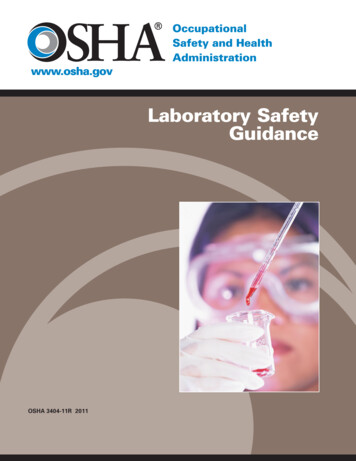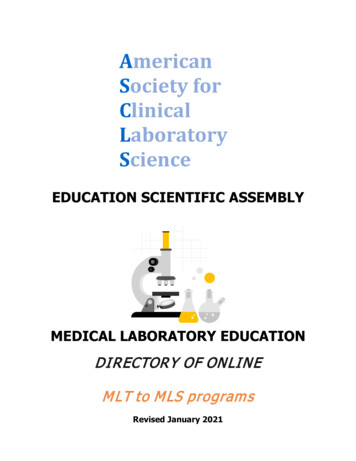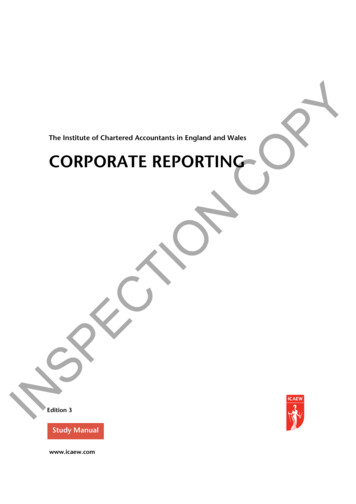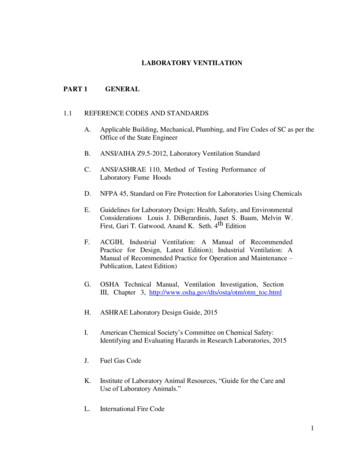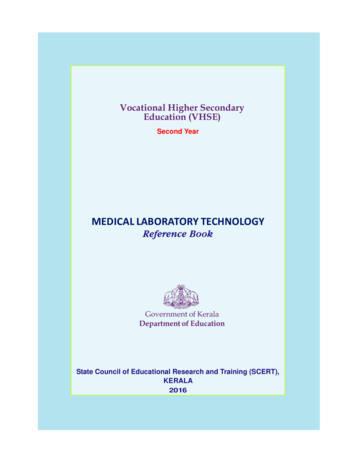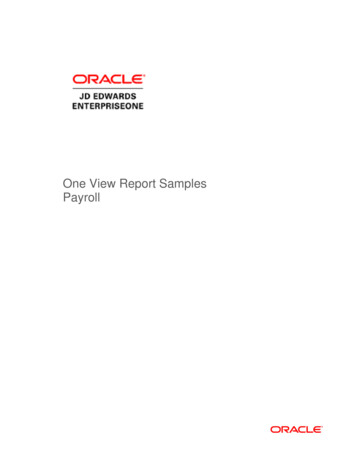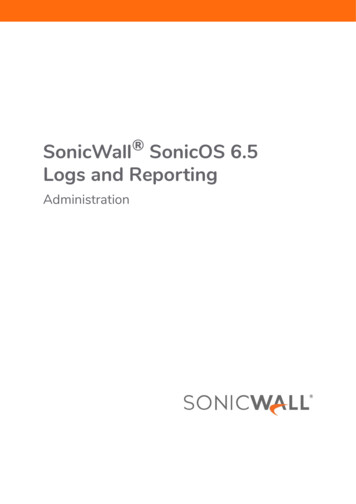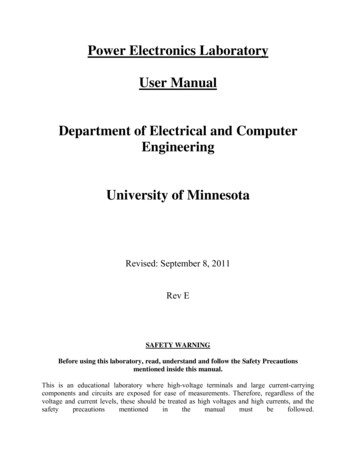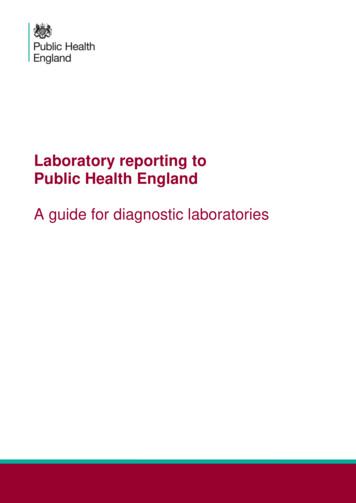
Transcription
Laboratory reporting toPublic Health EnglandA guide for diagnostic laboratories
Reporting to PHE: a guide for diagnostic laboratoriesAbout Public Health EnglandPublic Health England exists to protect and improve the nation’s health and wellbeing,and reduce health inequalities. We do this through world-leading science, research,knowledge and intelligence, advocacy, partnerships and the delivery of specialist publichealth services. We are an executive agency of the Department of Health and SocialCare, and a distinct delivery organisation with operational autonomy. We providegovernment, local government, the NHS, Parliament, industry and the public withevidence-based professional, scientific and delivery expertise and support.Public Health EnglandWellington House133-155 Waterloo RoadLondon SE1 8UGTel: 020 7654 8000www.gov.uk/pheTwitter: @PHE ukFacebook: www.facebook.com/PublicHealthEngland Crown copyright 2020You may re-use this information (excluding logos) free of charge in any format ormedium, under the terms of the Open Government Licence v2.0. To view this licence,visit OGL or email psi@nationalarchives.gsi.gov.uk. Where we have identified any thirdparty copyright information you will need to obtain permission from the copyright holdersconcerned. Any enquiries regarding this publication should be sent to [insert emailaddress].Published October 2020PHE publicationsgateway number: GW-1643PHE supports the UNSustainable Development Goals2
Reporting to PHE: a guide for diagnostic laboratoriesContentsThe purpose of 4Health protection (notification) regulations 20105PHE surveillance systems6Second generation surveillance system6Caldicott and data protection7Organism8UK standards for microbiology investigations9How to report10When to report10Who reports11What to report12Organisms/infections to be reported12Organisms/infections not to be reported in CDR extract13What information a report should contain13Core data13Organism-specific data15Augmented surveillance data15Antimicrobial susceptibilities17Appendix 1: notifiable organisms18Appendix 2 – core organisms24Appendix 3 – sterile sites29Appendix 4 – hepatitis B risk factors and groups30Appendix 5 – contacts313
Reporting to PHE: a guide for diagnostic laboratoriesThe purpose of surveillanceCommunicable disease surveillance has a number of goals:Detection The early detection of changes in the temporal, geographic and age distribution ofnew and known diseases that indicate outbreaks of infection, or changes in thepattern of sporadic diseases.Analysis Determining the exposure, prevalence, burden, morbidity, mortality, carriage andlong-term trends of infectious diseases.The generation of information on changes in the type, pathogenicity and drugresistance of the organisms causing human and animal disease.Monitor the use and coverage of an intervention, any adverse events arising fromthat intervention and the overall impact of disease control measures includingimmunisation.Monitor changes in properties such as prevalence, spatial distribution and timedistribution of disease-causing hazards including animal diseases, weather andsocial factors as well as population vulnerability and susceptibility.Action Enable appropriate and timely action to be taken in order to protect the public health.This will commonly be at the local level closest to the scene of incidents andoutbreaks, but in incidents that are more widespread the action may be regional,national or international, for example the COVID-19 pandemic. In rare instances, asingle case may require prompt national/international intervention, for example acase of SARS.Inform the development of policies to detect new threats and emerging problems, toreduce exposure to a particular hazard or to protect individuals in advance of suchexposure. Normally such policies will be developed nationally in the light of trends indisease and the available methods of prevention.Information Building information on the temporal, geographic and population distribution andepidemiology of new, poorly understood and well understood diseases for informing4
Reporting to PHE: a guide for diagnostic laboratories decision making for public health, health service planning, risk management,research and control priorities.Inform key disease eradication or control programs.Provide information to support the development of guidance for professionals on theclinical management of individual patients, the choice of the appropriate controlstrategy and the organisation of services to deliver them to those at risk.Ensure that the UK makes its full contribution to European and International effortsto protect health.Informing the public about the risks to individuals and the general public.In order to meet these surveillance objectives, it is essential that coverage of laboratoryreporting is complete and the information provided is accurate and timely. Thisdocument sets out standards and procedures that will enable the organisations to meetthe laboratory reporting surveillance requirements of Public Health England and theHealth Protection (Notification) Regulations 2010.Health protection (notification) regulations 2010Since October 2010 the Health Protection (Notification) Regulations (2010) haverequired diagnostic laboratories to notify PHE of the identification of specified causativeagents in a human sample (from live or deceased patients) within 7 days, wherecausative agent can be taken to mean: a causative agent listed in Schedule 2 of the Regulations (and replicated inAppendix 1) evidence of an infection caused by such an agentIt should be noted, however, that the existing voluntary reporting includes a morecomprehensive list of causative agents than that in the Notification Regulations, andnotification under these Regulations does not replace voluntary reporting to PHE, whichshould continue.The legal responsibility to ensure that laboratory notification is carried out in accordance withthe Notification Regulations rests with the corporate body that operates the testing service, thedirector of the laboratory or the relevant persons providing the diagnostic test.Further guidance on the health protection legislation can be found on the Department ofHealth’s archived dGuidance/DH 1145105
Reporting to PHE: a guide for diagnostic laboratoriesPHE surveillance systemsSecond generation surveillance systemThe Second Generation Surveillance System (SGSS) is an application that stores andmanages data on laboratory isolates and notifications, and is the preferred method forcapturing routine laboratory surveillance data on infectious diseases and antimicrobialresistance from diagnostic laboratories across England. The data is stored in a centraldatabase within PHE, and made available to a wide range of users within and outwiththe organisation, subject to robust access control mechanisms.Flowchart: Role-based access security modelThe flowchart shows that results generated by the Laboratory Information ManagementSystem (LIMS) can be sent to SGSS via different routes (that is, sFTP, web upload orencrypted email). Data Management processes then occur, which include validation,translation of local codes and data enrichment. Finally, the data is made available to theBusiness Intelligence software for analysis, reporting and data mining.Lablink software enables Communicable Disease Report (CDR) and AntimicrobialResistance Reports (AMR) reports to be transferred from laboratory informationsystems (LIMS) and the sent to SGSS via sFTP. It is also possible to upload the reportsdirectly to SGSS using the application’s user interface, and there is provision to senddata in the legacy encrypted CoSurv format.6
Reporting to PHE: a guide for diagnostic laboratoriesOnce the reports have been loaded into SGSS, each record is subject to a number ofvalidation processes, and local LIMS codes are translated to SGSS codes to standardisethe data for analysis. Patient data is validated against the Demographic Batch Service(DBS), and the record is updated with additional data received from the Spine.CDR records are transformed into cases using the OPIE principle (explained further in inthis document ) through a deduplication process, before the data is loaded into a datawarehouse for further analysis. AMR data is stored at a test level.Positive COVID-19 test results are sent multiple times a day from SGSS to the CTASsystem to provide information for NHS Test & Trace.Caldicott and data protectionIn order to achieve the objectives described on page 4 of this document, CommunicableDisease Surveillance needs to contain some patient identifiers in order to: enable duplicate reports from the same patient to be identified and avoid overestimation of disease prevalenceenable appropriate follow up to be undertaken with the reporting laboratoryenable outbreak investigation to be undertaken (geographic mapping from post codeor part post code)detect geographical and temporal clusters cases that may represent an outbreak(geographic mapping from postcode)examine association between environmental factors such as rainfall and animalpopulation (geographic linkage to other datasets from postcode)establish linkage, when appropriate and justified, with the reference laboratory dataon the organism concernedPHE undertakes to handle these data in accordance with the Data Protection Act 2018,General Data Protection Regulations (GDPR) and the Caldicott Guidelines. Specificallywe undertake to ensure that: personal identifiers for the minimum time period are held consistent with their publichealth purposeaccess controls to databases are restricted to named individuals with a need toknowpostcode data is held in a way that individual patients cannot be traced but linkageto Geographical Information Systems, census and other datasets is retainedpatient identifying data are not transmitted to others outside PHE without review ofthe legal purpose of the data sharing7
Reporting to PHE: a guide for diagnostic laboratoriesData containing any personal identifiers being transmitted to PHE electronically shouldbe encrypted. This happens automatically for all data sent via sFTP using the secureFTP protocol across N3 or the internet, and the SGSS web application uses 256 bit SSLencryption.PHE takes the Caldicott requirements very seriously and ensures that, in all areas ofactivity, its work is consistent with both the Caldicott guidelines and the Data ProtectionAct. Approval needs to be applied for on an annual basis and our cover under Section251 of the NHS Act (2006) is dependent on continued adherence to high quality datahandling standards.OrganismA record within the CDR component of SGSS is based upon the OPIE principle(Organism-Patient-Illness-Episode). OPIEs record episodes of infection whereby anepisode constitutes each positive organism in a patient in a defined period of time. If anindividual is infected by 2 different organisms (including 2 different sub-types of a singlespecies) at the same time, that individual will be represented by 2 distinct OPIEs.Similarly, if an individual is infected on 2 separate occasions by the same organism(with recovery implied between those 2 episodes of infection) they will be representedby 2 distinct OPIEs.The default episode length is 2 weeks, with the exception of Clostridium difficile - 4weeks, Influenza A - 6 weeks2 , Salmonella spp -13 weeks, Mycobacterium spp - 26weeks, Hepatitis B & C, HIV, HTLV and Creutzfeld-Jakob agent which have indefiniteepisode lengths. SARS-COV-2 currently has an indefinite episode length, but this isunder continuous review the virus becomes better understood.2The Influenza A episode period is set at 6 weeks to capture, within the same episode, the serology test requested for Avian Influenza at 28days.8
Reporting to PHE: a guide for diagnostic laboratoriesUK standards for microbiology investigationsThe UK Standards for Microbiology Investigations (SMIs) are a comprehensivereferenced collection of over 200 clinical microbiology Standard Operating Procedures,algorithms (for virology and serology), and guidance notes.SMIs promote high quality practices and help to assure the comparability of diagnosticinformation obtained in different laboratories. This in turn improves denominator dataand facilitates standardisation of surveillance. The methods are well referenced andrepresent a good minimum standard for clinical and public health microbiology. In usingSMIs laboratories should also take account of local requirements and may need toundertake additional investigations.Development of UK Standards for Microbiology Investigations (SMIs) are undertakenthrough the following working groups: the steering committee for the UK standards for microbiology investigationsthe UK standards for microbiology investigations – joint working group for syndromicalgorithmthe UK standards for microbiology investigations – working group for microbiologystandards in clinical bacteriologythe UK standards for microbiology investigations – working group for microbiologystandards in clinical virology/serologyUK standard for microbiology investigations (SMIs) are discussed and approved bymembers of the SMI working groups at meetings through open debate. SMIs take intoaccount the best options for patient care and management, and decisions are reachedby consensus although the option is available to vote on proposals. Before beingissued, SMIs are edited by a medical editor and the chairs of the working groups.NHS Evidence has accredited the process to produce SMIs. The accreditation isapplicable to all guidance produced since October 2009 using the SMI developmentprocesses. Accreditation is valid for 5 years from July 2011. The process for thedevelopment of SMIs is certified to ISO 9001:2008.They may be accessed from robiology-investigations-smi9
Reporting to PHE: a guide for diagnostic laboratoriesHow to reportSubmit laboratory reports to PHE either as electronic files: in the Lablink format described in Appendix 6, sent via secure sFTP. in the SGSS Excel template or the SGSS disease/test specific template, sent viasecure sFTP. in the Lablink format described in Appendix 6 or SGSS template formats describedabove, uploaded directly to SGSS via the web application.By directly entering thedata into the forms on the SGSS web applicationContact the regional SGSS support specialist to discuss electronic file transmission.Contact details are in Appendix 5Note:Laboratories may send reports to PHE in more than one of the formats outlined above,but only one report of any particular episode of illness due to a specific organism shouldbe sent.It is understood that private laboratories rapidly set up to support testing for the COVID19 pandemic do not always have established systems report results to PHE, however,there is a legal requirement to report. Laboratories in this situation should contact therelevant office listed in Appendix 5 or sgss.helpdesk@phe.gov.uk to discuss directlyhow to report.Point of care testing results must also be reported to PHE, instructions on how tofacilitate this can be obtained by contacting poct.contact@phe.gov.uk, with a descriptionof the proposed testing programme.When to reportDiagnostic laboratories are required to notify PHE of the identification of the causativeagents specified in Appendix 1 within a maximum 7 days, but daily reporting is preferredto enable timely public health action. COVID-19 positive test results should be reportedwith 24 hours, 7 days a week, so that timely contact tracing can be employed to preventonward spread of the virus, and if possible multiple times per day.10
Reporting to PHE: a guide for diagnostic laboratoriesLocal Health Protection Teams (HPTs) should be notified of urgent cases as soon asreasonably practicable after the identification of the causative agent. This should bedone orally, usually by telephone. It is recommended that this should always be donewithin 24 hours. Urgent oral notification should be followed up by written notificationwithin 7 days of identification of the causative agent.In determining whether a case is urgent, factors that should be considered include the: nature of the causative agent, for example a rare and/or re-emerging disease ease of spread of that causative agent, including the infectiousness of cases androute of transmission ways in which the spread of the causative agent can be prevented or controlled,taking into account, for example, immunisation, isolation and prophylactic treatment nature of the disease it causes, including morbidity and case-fatality specific circumstances of the case which might represent particular risks, such asoccupation, age and sex – it may be relevant, for example, if a patient is ahealthcare worker, a child attending nursery or a woman of child-bearing ageOverall, the key consideration will be the likelihood that an intervention is needed toprotect human health and the urgency of such an intervention.All other reports should be made as soon as possible after the organism has beenidentified, preferably at the same time that the laboratory report is being issued to therequester. Any subsequent information should be reported by updating the originalrecord on SGSS. Reports should be made no later than 6 months after identification. Ifcircumstances exist where reports older than 6 months will be made, please discussthis with your local SGSS support specialist.Who reportsIn most cases the source laboratory or testing service (for example, providers of Pointof-Care tests) will report to the PHE when they first receive the clinical specimen fromwhich an organism is cultured or otherwise identified. In some cases the sourcelaboratory will refer the specimen to a reference laboratory, which provides specialistdiagnostic or typing services for specific organisms. The reporting laboratory is thelaboratory submitting the report to PHE. All reports to PHE must identify the source andreporting laboratories (which will usually be the same) and where appropriate, thereference laboratory.11
Reporting to PHE: a guide for diagnostic laboratoriesNote:If the source laboratory refers a specimen to another laboratory (for whatever reason) aclear agreement as to which laboratory will report the specimen to PHE will be needed andcommunicated to the PHE FS team (see Appendix 8). Such an arrangement is necessaryto minimise the chance of both or neither laboratory submitting the report. Normally thesource laboratory will do the reporting, and, for the organisms specified in Appendix 1, it isthe source laboratory’s legal responsibility to ensure the case is notified to PHE. The dayof identification for notification purposes is taken as the day on which the source laboratorybecomes aware of the identification of the organism by the other laboratory.What to reportOrganisms/infections to be reportedThe CDR extract should have: all organisms specified in Schedule 2 of the Health Protection (Notification)Regulations 2010, and listed in Appendix 1 of this document all clinically significant infections caused by the organisms listed in Appendix 2 all clinically significant isolates from sterile sites such as blood, CSF, joint fluids,bone, pleural and pericardial fluids, heart valves, and abscesses in the brain, liverand spleen – Appendix 3 lists further sterile sites that may be considered to indicateinvasive disease every organism causing meningitis or encephalitis every organism causing haemorrhagic fever asymptomatic infections when of clinical or epidemiological relevance (for exampleviral infections in pregnancy, asymptomatic individuals associated with outbreaks,asymptomatic persons infected with HIV, Legionella pneumophila, or Salmonellatyphi)Due to surveillance requirements in advance of and during pandemic influenza,laboratories are now requested to report isolates and susceptibility test information forStreptococcus pneumoniae, Haemophilus influenzae and Staphylococcus aureus fromlower respiratory tract sites including sputum when this information can be providedautomatically (recognising that with the increase in reports, those laboratories thatreport manually may not be able to provide these data).Surveillance requirements during the COVID-19 pandemic require testing services toreport positive and negative results of tests seeking to detect SARS-CoV-2 (genes,antigen or antibody) and influenza virus.12
Reporting to PHE: a guide for diagnostic laboratoriesIn accordance with amendments to the Health Protection (Notifications) Regulations2010, from 1 October 2020 the AMR extract should include: all reports of bacteria that have tested positive for an acquired carbapenemase(identified either locally or at the national reference laboratory)all reports of bacteria that have antimicrobial test results (from 1 October 2020diagnostic laboratories have a duty to report antimicrobial susceptibility results for allcausative agents listed in Schedule 2) – all antibiotic susceptibility results should beincluded, including those suppressed on the LIMSany resistance mechanism(s) identified in any of causative agents listed in Schedule 2Organisms/infections not to be reported in CDR extract neisseria meningitidis identified in a throat swab should not be reported unlessassociated with invasive disease in that individualuncomplicated urinary tract infections unless caused by organisms listed inAppendices 1 or 2the isolation of BCG from immunisation sites unless associated with extensive localor disseminated BCG infectionNote:If a single organism is identified in different specimen types, report it only once, listingeach specimen type from which it was identified during that episode. If differentorganisms are identified as co-infections in the same patient they should all be reportedseparately.Report infections identified in mothers and their babies or foetuses as separateinfections by cross-referencing to the other report, using the following appropriatefeature description; child of infected mother; contact of case; maternal infection;perinatal transmission; pregnant and feature comment field if necessary.What information a report should containCore dataThe following core surveillance data are required on all reports submitted to PHE.Fields marked with an * are mandatory.13
Reporting to PHE: a guide for diagnostic laboratories Source Lab: ideally always be specifiedReference Lab: if relevantReporting Lab*: must always be specified, will usually be source lab, in some casesreference labPatient identification*: - one of the following must be present:o Patient’s surname and initial† or soundex code and initialo Patient’s Hospital number (Patient PID no.)o Patient’s NHS number†AMR data should contain either patient hospital number or NHS numberDate of birth (DOB)* †: the patient’s DOB where known or patient’s ageSex*†: male, female or not knownOrganism*†: the full organism name and any typing results, or the description of theillness (for example, toxic shellfish poisoning)Date of onset: (dd/mm/yyyy format) the date of onset of the illness caused by theorganism being reportedSpecimen type(s)*†: for example CSF, blood, sputum, serum (where the diagnosisis based on serology, please use serum as the specimen type)Specimen date(s)*†: (dd/mm/yyyy format): the date the specimen was collectedfrom the patient. If this is not known, use the date the specimen was received at thesource laboratoryIdentification method(s): the method used to identify the organismPostcode†: the full postcode of the patient residenceEthnicity†: required under the Race Relations Amendment Act 2001In addition to the items marked †, for notifications of organisms listed in Appendix 1insofar as it is known, the following information must also be provided to PHE: name and address of the diagnostic laboratory patient’s home address patient’s current residence (if not home address) name, address and organisation of the person who solicited the test which identifiedthe causative agent. Indicate if a patient is a Care Home resident Indicate if patient is a Health Care Worker any antimicrobial susceptibility test result and resistance mechanism(s) identifiedAMR data also requires the requesting organisation details. This is used by SGSS toindicate the source of the specimen and includes where the requesting organisation ofthe specimen is: a GP Practice the pathology system code will be translated to the NHS OrganisationData Service (ODS) practice code an acute hospital the pathology system code will be translated to the ODS site code a community hospital the pathology system code will be translated to the ODS Sitecode14
Reporting to PHE: a guide for diagnostic laboratoriesOrganism-specific dataThe following surveillance data are requested on all reports submitted to PHE: for SARS-CoV-2 antibody and antigen test results each report should containappropriate information on the testing method used (that is, test manufacturer andmodel desgination of device)each Hepatitis B report to contain information on whether the case is acute orchronic, and/or if the antibody to core IgM is positive or negativeo Note: The suggested case definitions for Hepatitis B are:Acute - HBsAg positive and anti-HBc IgM positive and abnormal liver function testswith a pattern consistent with acute viral hepatitis. Associated risk factors should bereported for all acute infections (Appendix 4).Chronic - HBsAg positive twice at least 6 months apart or HBsAg positive and antiHBc IgM negative and anti-HBc positive. Please also indicate when occurring in riskgroups such as pregnant women and health care workers (Appendix 4).each Hepatitis C report to contain information on the result for the Hepatitis C coreantigen (HCV AG) and/or the HCV RNA (which is usually detected by PCR test) –the feature codes HCV AG and HCV RNA should be used to capture these resultsclostridium difficile reports should indicate whether identified by toxin detection orculture of the organismcorynebacterium diphtheriae whether toxigenic & non-toxigenicEnteric Escherichia coli with the serotype specifiedplasmodium reports should specify the speciesall cases of acute infectious syphilis (primary, secondary or early latent in the first 2years) confirmed by the reference laboratoryIn addition to normal communicable disease deporting via SGSS there is a need tourgently inform the local Health Protection Team who would be expected to informColindale about conditions with severe or unusual presentations or of public orprofessional concern, for example toxic shock syndrome, toxic food poisoning, seriouscellulitis, gangrene, or infections that could indicate potential terrorist threat (for exampleanthrax, tularaemia).Augmented surveillance dataPHE has established a number of programme areas to tackle infectious diseasepriorities. These currently include: health-care associated infections and antimicrobial resistance gastrointestinal Hepatitis B and C HIV and sexually transmitted disease15
Reporting to PHE: a guide for diagnostic laboratories Vaccine-preventable diseasespandemic influenzatuberculosisemerging health threatsdeliberate releaseSurveillance is conducted for diseases other than those covered by programmes andthe routine generic reporting provided by the CDR system ensures that there is a safetynet able to detect incidents or increases across the broad number of infections coveredby CDR.For many organisms, certain clinical and epidemiological data represent importantuseful information. Inclusion of such data where laboratories have them is welcomed byPHE, but is not considered a mandatory part of the laboratory report. When these dataare recorded on request forms PHE would welcome their inclusion in electronic outputsvia Lablink as comment fields. In the future, when pathology and clinical systems maybe more closely linked, PHE would welcome the reporting of the following clinical andepidemiological features in a codified manner.Epidemiological features/Risk factorsRecent travel abroad (within 1 year prior toinfection) including dates and reasons fortravel1Resort country (where they have resided/travelled) 1Patient country (of birth) and dates theyfirst arrived in the UK 1OutbreakHospital acquiredSexual orientationAnimal contactTransplant recipientBlood recipientVaccine status2ImmunocompromisedPregnancyInjecting drug useCongenital infectionFood source/vehicleTransmission agent (person to person,waterborne, animal, foodborne)Clinical/syndrome ArthritisMeningitisInvasivePneumoniaCroupEnteric feverHUS(HaemolyticSyndrome)Asymptomatic16Uraemic
Reporting to PHE: a guide for diagnostic laboratoriesNotes:1 It is increasingly important to capture information on imported infections in migrantsand/or travellers because of changes in global epidemiology and travel patterns. For awide range of infections SGSS is the only way in which information about travel andmigration history can be captured. This information helps to target appropriate publichealth action.2All vaccine preventable diseases are under enhanced surveillance and laboratoriesmay be contacted for further details about the patient if key information is not suppliedas PHE are required to follow up most cases.Antimicrobial susceptibilitiesPlease report antibiotic susceptibility results via susceptibility section for all bacterialinfections, noting the following: extended-spectrum Beta-Lactamases (ESBLs) reports – If there is confirmatoryevidence that the isolate is an ESBL producer then please record in the antibioticfield using the “EXTENDED
Reporting to PHE: a guide for diagnostic laboratories . 4 . The purpose of surveillance . Communicable disease surveillance has a number of goals: Detection The early detection of changes in the temporal, geographic and age distribution of new and known diseases that indicate outbreak


